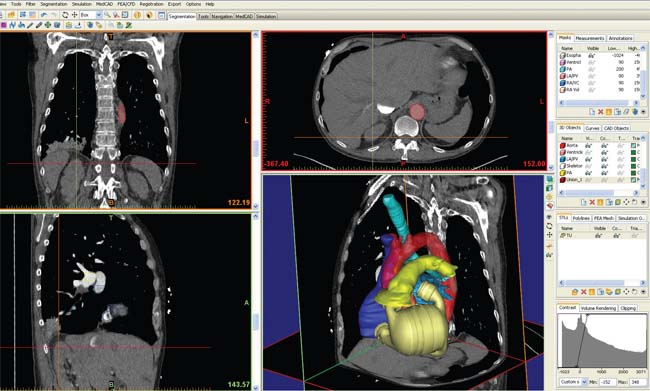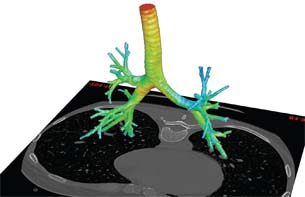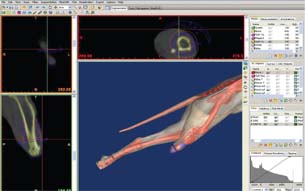Mimics Revolutionizes Life-Saving Device and Therapy Development
Rapid Tech that Will Change the World, Second Place: Materialise's MIS helps doctors and designers get a better view of the human anatomy.
December 1, 2009
By Colleen Wivell
When a person’s heart fails or someone needs a stent to improve cardiovascular health, it’s often difficult to figure out what treatment is best or know exactly where a medical device should be placed. Unlike a car with a hood, the human anatomy is not immediately accessible. To solve that challenge, Materialise developed the Mimics Innovation Suite, which links CT and MRI data with rapid technologies, FEA, CFD, and CAD.
 The Mimics interface shows a segmented model of a patient’s CT scan with the AbioCor artificial heart (in yellow in the scan and inset lower left) in position. Image courtesy of Abiomed, Inc. |
The Mimics Innovation Suite enables the visualization of a patient’s anatomy so medical engineers, researchers, and doctors can design patient-specific medical devices, understand what treatments will work best, and know exactly where to place lifesaving and life-improving appliances. It enables them to visualize the previously invisible, and engineer directly with anatomical data.
For these reasons, DE’s judges picked the Mimics Innovation Suite (MIS) as the second-place winner in the rapid technologies division of DE’s Change the World Challenge. The suite is comprised of Mimics and 3-matic software as well as engineering services. Mimics makes it possible to construct a 3D model based on CT scan or MRI data, enabling engineers and doctors to study specific internal human anatomy in a non-invasive way. It outputs STL files that are then used in 3-matic for patient-specific measurements and analyses, custom implant designs, and surgical guide designs.
 Segmented human airway colored according to total pressure. CFD calculations illustrate pressure distribution on the wall generated by the airflow through the model. Image courtesy FluidDA |
3-matic is the company’s program dedicated to working on anatomical data, a bridge to CAD or CAE. A variety of design and meshing operations can be performed directly on the imported 3D anatomical data generated in Mimics. Thus, the software eliminates the lengthy and error-prone process of reverse engineering. However, if the user needs to export the selected anatomical data or the design to CAD, then 3-matic’s automatic reverse engineering capabilities can speed up and simplify the process. 3-matic is designed to interface with Mimics seamlessly and allows export to any CAD program and all major CAE packages.
MIS has inspired top researchers around the globe to take their research to the next level, including pulmonary and cardiac R&D. Dr. Jan De Backer, CEO of FluidDA, and his team have been using the Mimics Innovation Suite to generate patient-specific airway models for airflow simulations (also for cardiovascular modeling). The models allow the team to assess the efficacy of a certain treatment (e.g., virtual stent implantation, inhaler delivery systems), eliminate treatments that don’t work, improve respiratory medical treatments, and design patient-specific devices.
Dr. Robert Kung, chief scientific officer of Abiomed, Inc., used MIS to calculate the distances between the cardiac inflows and outflows of numerous patients. From this data, Kung and his development team were able to design an artificial heart, the AbioCor, that would fit the greatest number of patients. Today, Kung’s team continues to use the software suite to determine whether a patient’s unique anatomical structures can accommodate the AbioCor and if they are a good candidate for the replacement heart.
Dr. Ola Harrysson, an associate professor at North Carolina State University (NCSU), teaches students in his biomodeling course how to use the Mimics Innovation Suite. During class, students design and print custom osseointegrated prosthetic limbs for disabled cats and dogs using Materialise software and Electron Beam Melting (EBM) technology. Though custom implants made via standard means are already available for humans, NCSU is collaborating with an orthopaedic group at Duke Medical Center to bring their unique process to the market.
 Mimics interface showing a segmented bone and soft tissue model of a dog with measurements of the dog’s leg and implant for a prosthesis. Image courtesy of North Carolina State University |
Similar to Dr. Harrysson’s research, nearly all major implant manufacturers are using MIS to design custom implants in the craniofacial and orthopaedic markets. An implant that is designed using patient-specific data will fit optimally, reduce operating-room time, improve implant longevity, and enable faster patient recovery times.
Materialise takes it one step further with their clinical software packages (SurgiCase CMF (cranio-maxillofacial) and SurgiCase Orthopaedics) which allow surgeons to define a virtual surgery plan based on patient CT or MRI data. SurgiCase software can be used to simulate osteotomies and evaluate implant size and placement. Once a plan is approved, a Materialise surgical guide is used to transfer the plan to the operating room with the utmost accuracy. Through this process, OR time is reduced and patient outcomes are improved. Although Mimics has been commercially available for 15 years, the Mimics Innovation Suite was launched in 2009 to provide doctors and biomedical engineers with a total solution. Since then, these doctors and designers have acted as pioneers in developing ways of using Materialise solutions for biomedical applications, moving rapid technologies into the realm of world-changing advancements where the possibilities are endless.
More Info:
Abiomed, Inc.
North Carolina State University
Colleen Wivell is general manager of Materialise USA. She has a BS in mechanical engineering with a minor in biomedical engineering from Carnegie Mellon. She started her career as a design engineer at Ford and joined Materialise in 1998. You can send comments about this article to [email protected].
Subscribe to our FREE magazine, FREE email newsletters or both!
About the Author
DE’s editors contribute news and new product announcements to Digital Engineering.
Press releases may be sent to them via [email protected].






